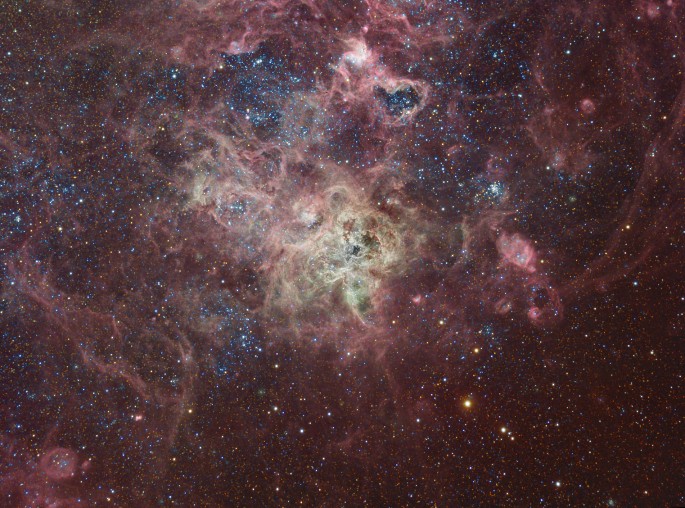
|
Credit & Copyright: Brad Moore
Explanation:
First
cataloged as a star, 30 Doradus is actually an
immense star forming region in nearby galaxy
The Large Magellanic Cloud.
The region's spidery appearance is responsible for its popular name,
the Tarantula
Nebula, except that this tarantula is about
1,000 light-years across, and 180,000 light-years away in
the southern constellation
Dorado.
If the Tarantual Nebula were at the distance of the
Orion Nebula
(1,500 light-years), the nearest stellar nursery to Earth, it
would appear to cover about 30 degrees
on the sky or 60 full moons.
The spindly arms of the
Tarantula Nebula surround
NGC 2070, a cluster
that contains some of the intrinsically brightest,
most massive stars known.
Intriguing details of the nebula's core can be seen in
this
remarkable skyscape, a composite
of 31 hours of exposure time.
This cosmic Tarantula
also lies near the site of the closest
recent supernova.
|
January February March April May June July August September October November December |
| |||||||||||||||||||||||||||||||||||||||||||||||||||||||
NASA Web Site Statements, Warnings, and Disclaimers
NASA Official: Jay Norris. Specific rights apply.
A service of: LHEA at NASA / GSFC
& Michigan Tech. U.
Based on Astronomy Picture
Of the Day
Publications with keywords: star cluster - star formation - 30 Doradus - LMC
Publications with words: star cluster - star formation - 30 Doradus - LMC
See also:
- APOD: 2025 December 28 Á NGC 1898: Globular Cluster in the Large Magellanic Cloud
- NGC 253: Dusty Island Universe
- APOD: 2025 October 26 Á Halloween and the Ghost Head Nebula
- APOD: 2025 October 21 Á IC 1805: The Heart Nebula
- Young Suns of NGC 7129
- APOD: 2025 October 8 Á NGC 7380: The Wizard Nebula
- APOD: 2025 December 9 Á The Heart of the Soul Nebula
